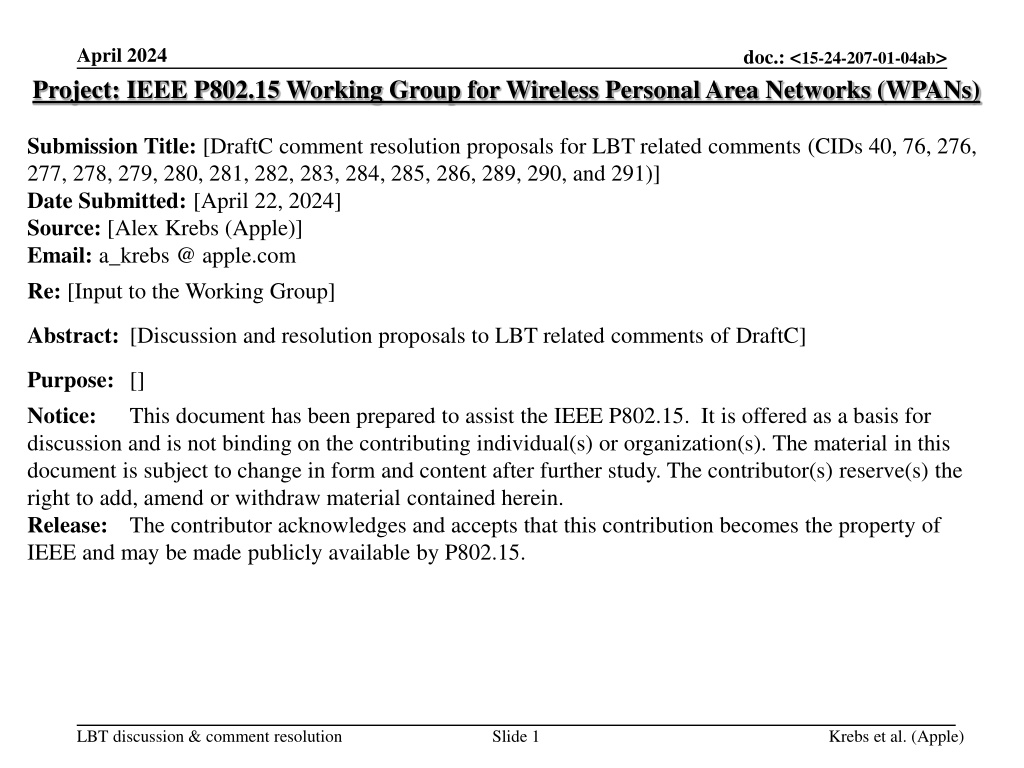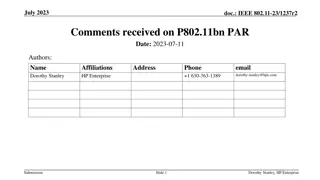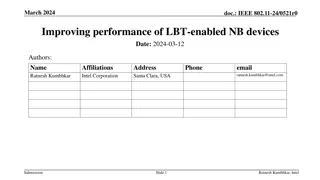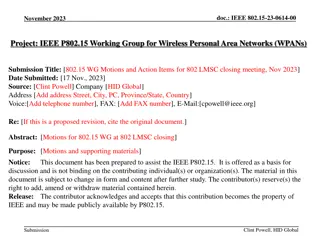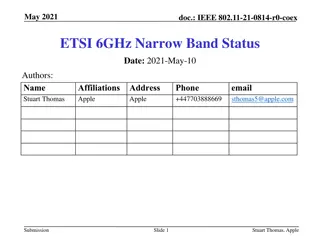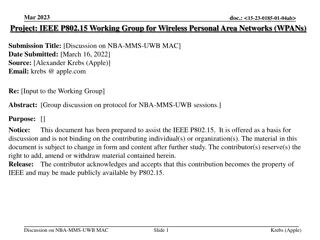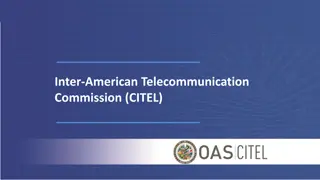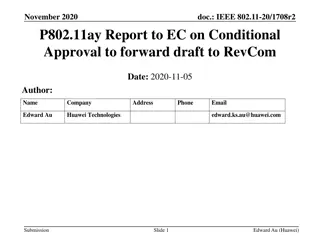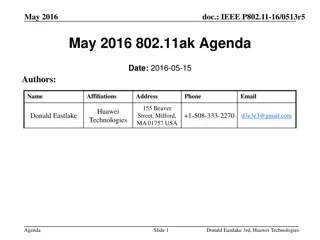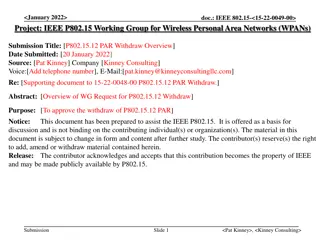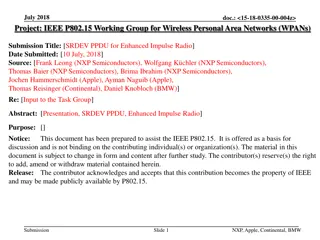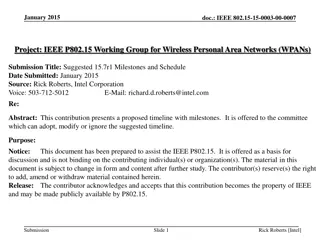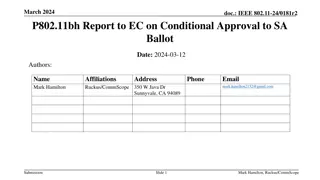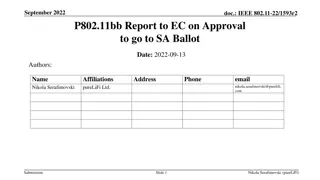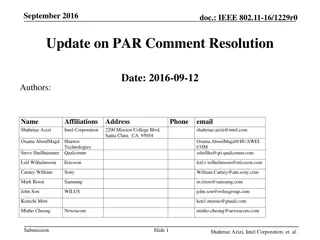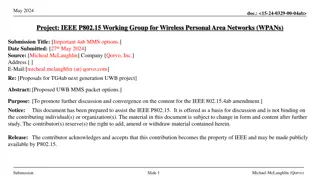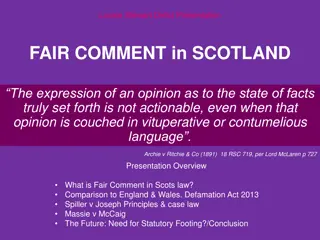Draft Comment Resolution Proposals for LBT Related Comments - IEEE P802.15 Working Group
Discussion and resolution proposals for comments related to Listen Before Talk (LBT) in DraftC document submitted by Alex Krebs from Apple to the IEEE P802.15 Working Group. The document covers regulatory aspects, contributions, conclusions, and recommended steps for LBT implementation in wireless personal area networks.
Download Presentation

Please find below an Image/Link to download the presentation.
The content on the website is provided AS IS for your information and personal use only. It may not be sold, licensed, or shared on other websites without obtaining consent from the author. Download presentation by click this link. If you encounter any issues during the download, it is possible that the publisher has removed the file from their server.
E N D
Presentation Transcript
April 2024 Project: IEEE P802.15 Working Group for Wireless Personal Area Networks (WPANs) doc.: <15-24-207-01-04ab> Submission Title: [DraftC comment resolution proposals for LBT related comments (CIDs 40, 76, 276, 277, 278, 279, 280, 281, 282, 283, 284, 285, 286, 289, 290, and 291)] Date Submitted: [April 22, 2024] Source: [Alex Krebs (Apple)] Email: a_krebs @ apple.com Re: [Input to the Working Group] Abstract: [Discussion and resolution proposals to LBT related comments of DraftC] Purpose: [] Notice: discussion and is not binding on the contributing individual(s) or organization(s). The material in this document is subject to change in form and content after further study. The contributor(s) reserve(s) the right to add, amend or withdraw material contained herein. Release: The contributor acknowledges and accepts that this contribution becomes the property of IEEE and may be made publicly available by P802.15. This document has been prepared to assist the IEEE P802.15. It is offered as a basis for LBT discussion & comment resolution Slide 1 Krebs et al. (Apple)
April 2024 doc.: <15-24-207-01-04ab> Content LBT discussion (p.3-7) Quick catch up on regulatory & coex discussion Recap of LBT contribution(s) presented to 802.15.4ab Conclusions & recommended way forward Comment resolution (p.8-18) Related 4ab/4me comments previously resolved DraftC comment resolution proposals LBT discussion & comment resolution Slide 2 Krebs et al. (Apple)
April 2024 doc.: <15-24-207-01-04ab> Regulatory summary UNII-3 (5725-5850 MHz) and UNII-5 (5925-6425 MHz) is shared unlicensed spectrum between 802.11 and 802.15.4ab and other wireless technologies in both ETSI and FCC regulatory domains EC approved harmonized standards for 5.8 GHz ETSI EN 300 440 (Final draft v2.1.1, 2017): No LBT (802.11/.15, BT, ...) ETSI EN 301 893 (v2.1.1, 2017): v2.2.1 adding sub-band 4 currently in ENAP, raised 20 dBm output power limit for WB (802.11, 3GPP, ...) 6 GHz standard under active development in ETSI BRAN ETSI EN 303 687 (Early draft v1.1.3, 2024-02-23) market demand analysis, no preferential treatment of one wireless technology over another, consensus driven, one vote per company current status: active open work item (OWI) on NB/WB coexistence, no text draft for OWI yet, very fruitful technical discussions LBT discussion & comment resolution Slide 3 Krebs et al. (Apple)
April 2024 doc.: <15-24-207-01-04ab> Contributions 802 & others Only 1 contribution in IEEE 802.15.4ab Effect of no-LBT NB on 802.11 devices, Carlos Aldana (Meta), 15-23-284r2 36 contributions on LBT, eDAA/rDAA, SCD, and other methods presented in ETSI BRAN and 802.11 CoexSC since 2023 Document number Title Submitting entity Year DCNRev Title CCA Modes in 802.15.4 Authors Carlos Aldana (Meta) Carlos Aldana (Meta), Menzo Wentink (Qualcomm) Carlos Aldana (Meta) Carlos Aldana (Meta) Carlos Aldana (Meta), Menzo Wentink (Qualcomm) Menzo Wentink (Qualcomm) Menzo Wentink (Qualcomm) Menzo Wentink (Qualcomm) Menzo Wentink (Qualcomm) Menzo Wentink (Qualcomm) Menzo Wentink (Qualcomm) Menzo Wentink (Qualcomm) Ratnesh Kumbhkar (Intel) Ratnesh Kumbhkar (Intel) Ratnesh Kumbhkar (Intel) Stuart Thomas (Apple) BRAN(23)119007 Spectrum Sharing Wide-band vs Narrow-Band Wide-band vs Wide-band and more Apple (UK) Limited 2024 360 3 2024 148 0 2024 130 0 2023 12591 NB Simulation Results Comparison Effect of no-LBT NB on 802.11 devices: Part 2 Effect of no-LBT NB on 802.11 devices BRAN(23)121007 VR simulation scenarios for narrowband-wideband coexistence studies Meta Ireland BRAN(23)121008 IEEE 802.11 and Bluetooth Coexistence Simulations Ericsson GmbH Eurolab 2024 148 0 2024 122 0 2023 20810 2023 16220 2023 12790 2023 455 0 2023 454 0 2023 453 0 2024 521 0 2024 2023 15030 2023 877 0 NB Simulation Results Comparison Bluetooth isochronous audio with LBT BLE interference to XR/VR Wi-Fi NBFH coexistence with Wi-Fi NB with LBT Wi-Fi deferral for NB signals Impact of BT on WLAN performance NB overview Improving performance of LBT-enabled NB in UNII-3 band Proposal for Bluetooth and Wi-Fi Coexistence in 5 and 6GHz Bluetooth Wi-Fi Coexistence: Channel Access Simulation Study Narrow Coex Studies Balancing Wideband & Narrowband Frequency Hopping Channel Access Mechanisms for Operation in 6GHz Follow-up to IEEE 802.11-24/0055r0 Puncturing for Coexistence BRAN(23)121013 NB simulation results comparison Qualcomm Tech. Netherlands B.V BRAN(23)122011 Effect of LBT on the coexistence of narrowband and wideband systems NBFH test signal draft text Meta Ireland BRAN(23)121011r5 Ericsson France S.A.S BRAN(24)123013 Bluetooth isochronous audio with LBT Qualcomm Tech. Netherlands B.V BRAN(24)123011 Balancing Wideband and Narrowband Frequency Hopping Channel Access Mechanisms for Operation in 6GHz Ericsson GmbH Eurolab BRAN(24)123017 Secondary Channel Deferral LBT for narrow band frequency hopping systems Ericsson LM 7 0 BRAN(24)123018 Background for the first 6 GHz harmonised standard Ericsson France S.A.S BRAN(24)123020 Response to BRAN(24)123013 Ericsson France S.A.S 2024 603 2 2024 445 0 Sebastian Max (Ericsson) Sebastian Max (Ericsson) BRAN(24)123021 NB channel access with LBT Qualcomm Tech. Netherlands B.V BRAN(24)123015r1 NB interference on WB signal Ericsson France S.A.S 2024 2023 19990 2023 14771 55 0 Evaluation of Puncturing for Coexistence of IEEE 802.11 and Bluetooth in 6 GHz IEEE 802.11 Beacons and Bluetooth Coexistence Simulations IEEE 802.11 and Bluetooth Coexistence Simulations Sebastian Max (Ericsson) Sebastian Max (Ericsson) Sebastian Max (Ericsson) BRAN(24)123008r1 Enabling LBT for narrowband FHSS transmission Intel Corporation SAS BRAN(24)123010 NB test signal issues Qualcomm Tech. Netherlands B.V Intel Americas Inc. Broadcom (EU) LBT discussion & comment resolution Slide 4 Krebs et al. (Apple) Meta Ireland MediaTek Inc.
April 2024 doc.: <15-24-207-01-04ab> Previous IEEE discussion on 15-23-285 Effect of no-LBT NB on 802.11 devices , Carlos Aldana et al. (Meta) For No LBT, a 3% duty cycle causes ~50% increase in P95 latency simulation of BT as 100% duty cycle (p.7), impossible BT connection interval simulation parameters (p.8-10), NB operation only on 802.11 primary channels (p.19), ... no comparison with other methods same simulation results presented at ETSI BRAN #122 and 802.11 CoexSC Panama F2F with diverging conclusions Meta Ireland (Claudio da Silva) points out in BRAN(23)112011 that LBT impact to NB is unknown and would still need to be assessed (link) 802.11-24/148r0 removes mention of missing LBT impact assessment on NB for straw poll on in 802.11 only CoexSC session LBT discussion & comment resolution Slide 5 Krebs et al. (Apple)
April 2024 doc.: <15-24-207-01-04ab> Is LBT really great? CCA/EDT LBT is a rudimentary method to resolve packet collisions No conflict avoidance, only one packet survives, greedy TXOP wins LBT prioritizes 802.11 over BT traffic (11-23/1503r0 [R. Kumbhkar, Intel], 11-23/1477r1 [S. Max, Ericsson]) BLE devices are generally not well suited to utilize LBT [Bluetooth Low Energy Regulatory Aspects Document (RAD) v1.01, BT Regulatory Expert Group, March 2023] eDAA and SCD were presented, aiming to efficiently manage coexistence by preventing packet collision before happening collaboration on eDAA/rDAA presented in 11-23/1503r0, concluding in asking 802.11 to converge on realistic simulation scenarios and performance metrics for both Bluetooth and Wi-Fi thwarted by adding sub 10ms AR/VR WiFi latency requirements (11-23/1259r1) effectively ending coex discussion by claiming LBT as the solution, w/o comparison since then, discussions in IEEE are overshadowed by 802.11 voter dominance* and coex discussion has moved into other forums *723 vs 136, as of December 2023: 802.11 vs 802.15 LBT discussion & comment resolution Slide 6 Krebs et al. (Apple)
April 2024 doc.: <15-24-207-01-04ab> Recommended way forward Coex discussion is more appropriately handled in ETSI Commit to finding the best coexistence solution with no hierarchy or priority given to either wide-band or narrow-band technology asserting both have equal rights to use the 5925-6425 MHz band within the bounds of regulation as stated in ECC Decision (20)01 and the subsequent implementing decision EU 2021/1067 Adding mandatory LBT/coex requirements to 802.15.4ab is nonsense risks voiding the 802.15.4ab standard by violating yet unknown 6 GHz regulatory rules (e.g. due to very specific CCA parameter definitions) deprioritizes 802.15.4ab behind all other 5.8 GHz 802.11, 3GPP, BT, ... Reject 15.4ab comments submitted against draft C that assert LBT is the only way of spectrum sharing put the 4ab standard at risk of violating regulatory rules deprioritize access of 802.15 radios behind other wireless technologies operating in shared unlicensed spectrum LBT discussion & comment resolution Slide 7 Krebs et al. (Apple)
April 2024 doc.: <15-24-207-01-04ab> Previous WG15 comment resolutions 15-23-591-01-4ab Draft B #235 ( Restrict 802.15.4ab BW in 6 GHz , #236: Disallow 802.15.4ab access to 802.11 PSCs in 6GHz unilaterally deprioritized access for 802.15 to unlicensed spectrum restricting NB bandwidth increases coexistence conflicts Rejected/withdrawn 15-23-497-22-4me (LB203): #r3-3 and #r3-5 ( add specific EDT values -80dBm/MHz ), #r3-4 ( add duty cycle restriction to CCA mode 4 ) 802.15.4-2020 specifically notes no mandatory values are defined in order to be able to meet regulatory requirements (P802-15- 04me-D01, p.619) unilaterally deprioritized access for 802.15 to unlicensed spectrum Rejected/withdrawn LBT discussion & comment resolution Slide 8 Krebs et al. (Apple)
April 2024 doc.: <15-24-207-01-04ab> 802.15.4ab Draft C resolution proposals LBT discussion & comment resolution Slide 9 Krebs et al. (Apple)
April 2024 doc.: <15-24-207-01-04ab> Line #Comment LBT is proven to be a great coexistence technique. Given that there is no mandatory coexistence technique for NB, LBT should be made mandatory. Replace "can" with "shall" and remove "the use of this may be mandated depending on local regulations" LBT is proven to be a great coexistence technique. Given that there is no mandatory coexistence technique for NB, LBT should be made mandatory. Replace the sentence "LBT may be applied to all channels in the absence of regulatory constraints, for example, to improve coexistence with other spectrum users." with "LBT shall be applied to all channels to improve coexistence with other spectrum users". There are simulations in Nov 2023 802.15 and 802.11 sessions shown NB impact to wifi coex. Suggest to adopt a mandatory LBT for NB transmission if aggregated NB duty cycle is more than a threshold NB coexistence with other technologies in UNII-3 and UNII-5 bands needs to be addressed. A good option is what has been suggested in DCN 285/Rev2, to mandate LBT for high duty cycle NB operation. Proposed Change Categor y Sub- clause Name Index # Page As in comment Carlos Aldana Techni cal 10.38.4. 2 276 51 6 As in comment Carlos Aldana Techni cal 10.38.8. 3 280 58 4 as in comment Li-Hsiang Sun Gener al 40 29 10 3 Change: "LBT shall be applied to channel numbers 50 to 249 according to regulatory constraints. LBT may be applied to all channels in the absence of regulatory constraints, for example, to improve coexistence with other spectrum users." To: "LBT shall be applied to channel numbers 50 to 249. LBT shall be applied to channels 0-49, for NB duty cycle >= TBD%." Pooria Pakrooh Techni cal 10.38.8. 3 76 58 3 ~ LBT is good/great, mandatory LBT in UNII-3 w/wo DC LBT discussion & comment resolution Slide 10 Krebs et al. (Apple)
April 2024 doc.: <15-24-207-01-04ab> CIDs 276, 280, 40, 76 (see previous slide) Proposed resolution: Reject Disposition detail: The group assesses that no assessment has been presented to the group on how LBT would affect narrowband radios following the upcoming 802.15.4ab standard despite claiming LBT is great, no information has been presented by the commenters to show that LBT is generally favorable over the methods currently being discussed in other coexistence and regulatory standardization forums one-sided requirements (with, or without depending on duty cycle) only applicable to 802.15.4ab unjustly deprioritize 802.15.4ab radios from accessing unlicensed spectrum shared with other wideband radios following 802.11 or 3GPP standard and possibly narrowband radios following BT SIG, or other standards in the future LBT discussion & comment resolution Slide 11 Krebs et al. (Apple)
April 2024 doc.: <15-24-207-01-04ab> Line #Comment The statement "LBT shall be applied to channel numbers 50 to 249 according to regulatory constraints." should be clarified as the word "according" is ambiguous. After reading the subsequent sentence, I think the author meant "in the presence of regulatory constraints". If that's the case, then regulatory constraints are already mandating LBT and the aforementioned statement does not provides additional information. Replace with "LBT shall be applied to channel numbers 0 to 249." Proposed Change Categor y Sub- clause Name Index # Page As in comment Carlos Aldana Techni cal 10.38.8. 3 279 58 3 Proposed resolution: Reject Disposition detail The group assesses that the current text is accurate in stating that LBT shall be used for channels 50-249 subject to the existence of a regulatory requirement but may also be used in the absence of regulatory requirements to e.g. improve coexistence with other radios Regarding channel 0-49, the group assesses one-sided requirements only applicable to 802.15.4ab unjustly deprioritize 802.15.4ab radios from accessing shared unlicensed spectrum between 5725 MHz and 5850 MHz behind other wireless technologies LBT discussion & comment resolution Slide 12 Krebs et al. (Apple)
April 2024 doc.: <15-24-207-01-04ab> Line #Comment How long is the CCA duration? Figure 35 suggests 9us, but there is no text that says that. Please add text that specifies the minimum CCA duration. What is the Energy Detect (ED) Threshold that should be used? Please specify. Proposed Change Categor y Sub- clause Name Index # Page As in comment Carlos Aldana Techni cal 10.38.8. 3 277 57 15 As in comment Carlos Aldana Techni cal 10.38.8. 3 278 57 15 In Figure 35, there is at least 100us of idle time between successive transmissions. There is no text that describes this idle time. Please add corresponding text that accomodates required idle time. In Figure 35, there is at least 100us of idle time between successive transmissions. If the ranging slot duration is 300 RSTU (250us), will there be enough time to accommodate this idle time? If there is not enough time, what is expected behavior? In Figure 35, there is an upper bound of 95% of the ranging slot on the transmission duration. There is no text associated with this. Please add such text. How does the initiator determine whether a channel is unavailable, unusable, or inefficient? Is it via passive scanning? If so, how long is the passive scanning duration? How accurate should this result be? What energy detect threshold should be used? All this needs to be specified. As in comment Carlos Aldana Techni cal 10.38.8. 3 289 58 17 Please clarify Carlos Aldana Techni cal 10.38.8. 3 290 58 17 As in comment Carlos Aldana Techni cal 10.38.8. 3 291 58 17 As in comment Carlos Aldana Techni cal 10.38.8. 4.2 286 58 18 see next slide LBT discussion & comment resolution Slide 13 Krebs et al. (Apple)
April 2024 doc.: <15-24-207-01-04ab> Draft C p.57 shown on this slide see next slide LBT discussion & comment resolution Slide 14 Krebs et al. (Apple)
April 2024 doc.: <15-24-207-01-04ab> CIDs 277, 278, 286, 289, 290, 291 (see previous two slides) Proposed resolution: Revise Disposition detail: The group assesses that the currently provided draft text inappropriately mandates specific regulatory rules from the EU regulatory domain (of one specific frequency band) to all frequency bands globally Following the existing 802.15.4-2020 standard, the group agrees to remove all regulatory domain specific values from the draft text and to keep the existing language according to regulatory constraints instead, following e.g. P802-15-04me-D01, p.619) The group instructs the technical editor to remove text p.57 l.15 and following starting at After completing the CCA to p.60 l.2 (including Figure 35) and to remove [B3] from the bibliography (p.192) LBT discussion & comment resolution Slide 15 Krebs et al. (Apple)
April 2024 doc.: <15-24-207-01-04ab> Line #Comment Figure 36 has a typo in the WLAN 20 MHz channel list. "168" should be "165". Proposed Change Categor y Techni cal Sub- clause 10.38.8. 4.2 Name Index # Page As in comment Carlos Aldana 281 59 1 There is no text associated with "Scaling Factor" in Figure 36. Please add text that describes this feature. Carlos Aldana Techni cal 10.38.8. 4.2 282 59 2 Proposed resolution: Revise Disposition detail The group has revised the text before in correspondence to CIDs 21, 22, 25, 28, 164, and 166 in DCN 15-23-0575-02-4ab and assesses no further action is needed LBT discussion & comment resolution Slide 16 Krebs et al. (Apple)
April 2024 doc.: <15-24-207-01-04ab> Line #Comment The following 802.11 20 MHz channel center frequencies are likely to have a lot of traffic (probe request, beacons from 6GHz only APs, and probe responses) and should be removed from the initial macMmsNbChannelAllowList to prevent ranging outages: 5975, 6055, 6135, 6215, 6295, and 6375 MHz Proposed Change Categor y Sub- clause Name Index # Page Remove channels 66:73, 98:105, 130:137, 162:169, 194:201, 226:233 from the table Carlos Aldana Techni cal 10.38.11 .1 284 102 18 Proposed resolution: Accept LBT discussion & comment resolution Slide 17 Krebs et al. (Apple)
April 2024 doc.: <15-24-207-01-04ab> Line #Comment The following 20 MHz block of frequency is not used by 802.11 devices in UNII-1: 5150-5170 and could be added to the frequency list to increase the number of channels allocated for NB. The following 20 MHz block of frequency is not planned to be used by 802.11 devices in UNII-5: 5925-5945. Redefine the UNII-5 frequencies so that k=50, 249 is replaced with 50, 57 Proposed Change Categor y Sub- clause Name Index # Page As in comment Carlos Aldana Techni cal 11.1.3.1 5 283 147 11 As in comment Carlos Aldana Techni cal 11.1.3.1 5 285 147 11 Proposed resolution: Reject Disposition detail The group assesses that isolated sub-band access to UNII-1 is unfavorable due to physical and regulatory constraints for 802.15.4ab narrowband radio The group assesses that prohibitive access restrictions in 5925-5945 MHz may apply subject to regulatory domain, e.g. due to concurrent GSM-R operation (European Rail Traffic Management System) LBT discussion & comment resolution Slide 18 Krebs et al. (Apple)
